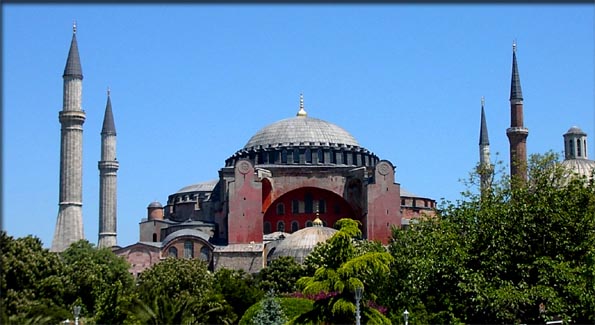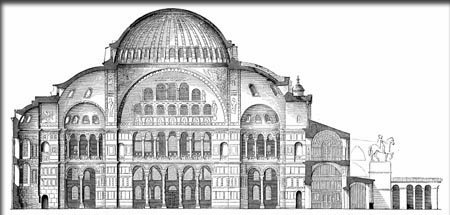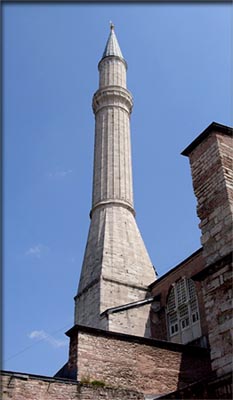 |
Hagia
Sophia: The Place of Holy Wisdom
|

In 330
AD, Constantine the Great, the first Roman Emperor to convert
to Christianity, founded the city of Constantinople on the Bosphorus
Strait at the intersection of the continents of Europe and Asia.
The city would soon become the capital of the Eastern Roman
Empire. A great Christian city needed a great cathedral, so
shortly after the founding a large church known as Hagia Sophia
("Church of the Holy Wisdom of God") was built. It only lasted
until 404 AD, however, when a rioting crowd burned the church
down. A second church was built in 415, but this was also burned
to the ground in a rebellion in 532 AD.
Only
39 days after the destruction of the 2nd church, the Emperor
Justinian I (also known as "Justinian the Builder") ordered
construction to start on a third church. While the first two
basilicas, however, had used the traditional design of western
cathedrals, Justinian hired two Greeks from Asia Minor to design
something completely different. Isidorus of Miletus, a physicist,
and Anthemius of Tralles, a mathematician, created a structure
consisting of a series of domes and half domes that would amaze
the world. Considered the embodiment of the Byzantine style,
it is said to have "changed the history of architecture" and
was, for nearly a thousand years, the largest cathedral in the
world.
|
Seven
Quick Facts
|
| Height
at dome top: 180 feet (55m) |
| Dome
diameter: 102 feet (31m). |
| Constructed
from: 532 AD to 537 AD |
| Function:
Church (537 - 1453), Mosque (1453 - 1931) Museum
(1934 - present). |
| Built
by: Emperor Justinian |
| Made
of: Brick with limestone and sandstone in some sections. |
| Other:
Largest cathedral in
the world from 537 AD - 1520 AD. |
Byzantine
Architecture
The
architecture of the Byzantine Empire was a mixture of the earlier
Greek and Roman style with Asian/ Oriental influences. It often
utilizied a large dome set on a square base instead of a vaulted
roof. Rounded arches and spires also were common features on
Byzantine buildings. Bricks of different colors were frequently
used on the outside of the structure and arranged so that they
appeared as bands or in complex patterns. Inside, the walls
were usually made of marble with colored glass mosaics.
The
central part of this third and final version of Hagia Sophia
was designed as a rectangle 250 feet (76m) long and 220 feet
(67m) wide. At the center of this was a square. One hundred
and eighty feet above the square was a massive dome. At over
a hundred feet across it was by far the largest dome ever constructed
at the time and often compared to the vault of heaven itself.
The dome was supported by four huge columns at the corners of
the square. At the east and west ends of the rectangle the roofs
consisted of two half domes which leaned in toward the main
dome giving it support. In turn, at each end of the building
other smaller half domes leaned in on the sides of the east
and west half domes holding them in position. At the north and
south exteriors of the central square of the building were two
huge, rounded arches that helped support the roof.
|

A
cross-section of the church from 1908.
|
Justinian
had an imperial room built on site so that he could continually
monitor the project's progress. He brought in materials from
all over the world for the construction including stone from
Egyptian quarries in Porphyry, green marble from Thessaly, and
yellow rock from Syria. Dividing the 10,000 workers into two
groups he had them compete with each other to complete the east
and west halves of the building. This final version of Hagia
Sophia was ready for dedication in just six years on December
27 of 537 AD. However, work on the interior mosaics continued
throughout the reign of Justianian's son from 565 to 578.
The
interior of the building was richly adorned with four acres
of gold mosaics on the ceiling. Multicolored marble was used
on the walls, floors and columns. Above the altar were hung
rich silk banners. When Justinian had finished the construction
he supposedly proclaimed, "Solomon, I have outdone thee!"
Historian
Procopius of Caesarea visited the church not long after it was
completed in the 6th century. According to him, Hagia Sophia
was "distinguished by indescribable beauty, excelling both in
its size, and in the harmony of its measures, having no part
excessive and none deficient; being more magnificent than ordinary
buildings, and much more elegant than those which are not of
so just a proportion. The church is singularly full of light
and sunshine; you would declare that the place is not lighted
by the sun from without, but that the rays are produced within
itself, such an abundance of light is poured into this church…"
Quake
Damage
The
region around Constantinople was prone to earthquakes and the
Hagia Sophia was often shaken by heavy tremors. In 558 AD, a
trembler caused a large part of the dome to collapse. Because
the original architects were dead by then, Isidorus's nephew,
Isidorus the Younger, was given the rebuilding job. He made
the new dome 20 feet higher which allowed its weight to be more
easily transmitted to the edges, strengthening the structure.
He also added four pendentives ( sort of a column with a half
curved arch on each side) under the dome to more effectively
transfer the weight to the supports below. This new dome lasted
for almost four hundred years before it needed major repairs.
Originally
the interior of the basilica was finished with mosaics and statues
depicting the saints. In 726, however, the emperor Leo the Isaurian
enacted laws forbidding the veneration of images and all these
icons were covered over or removed from the church.
Hagia
Sophia survived a fire in 859 and an earthquake in 869. A major
quake in 989, however, caused the western half-dome to fall
and Emperor Basil II asked the great Armenian architect Trdat
to direct the repairs. He went on to do a major restoration
of the church. By then the laws forbidding images had been relaxed
and new paintings were created on the dome and other parts of
the building depicting Jesus, the Virgin Mary, and many of the
saints and prophets.
In
1054 the Great East-West Schism divided the church into what
would become the Eastern Orthodox Church and the Roman Catholic
Church. Constantinople was in the territory under the influence
of the Eastern Orthodox Church until 1204 AD. At that time,
during the fourth crusade, the city was occupied by forces loyal
to the Roman Catholic Church who stripped the cathedral of many
of its relics (such as a stone from the tomb of Jesus and the
bones of several saints). These were sent back to churches in
the West.

One
of the minarets added after the church was converted
to a mosque.
|
From
Church to Mosque
In 1261
forces of the Byzantine Empire recaptured the city and the church.
They would hold it for almost 200 years until 1453 when Sultan
Mehmed, of the Ottoman Empire, laid siege to Constantinople.
After 53 days he conquered the city and allowed his troops three
days to pillage the metropolis (now renamed Istanbul) including
the church. By the time the Sultan put a stop to the looting,
Hagia Sophia was in a deplorable state. The Sultan, intent on
converting Constantinople to Islam, turned Hagia Sophia into
the Aya Sofya Mosque.
As a
mosque the mosaics and paintings were once again covered with
plaster. Over the next century two small minarets (tall, round
towers used to call the faithful to prayer) were built on the
southwest and northeast corners of the building. In the 16th
century these were removed and two larger minarets were constructed
near the east and west edges of the building. In the 17th century
the great Ottoman architect Mimar Sinan was commissioned to
strengthen the building to better resist earthquakes. He also
constructed two additional minarets so that the edifice was
then surrounded by four of them at each of the corners.
Though
the building was not constructed as a Moslem place of worship,
it was greatly admired in the Islamic world. For almost half
a millennium it served as the principal mosque of the city of
Istanbul. Its architecture heavily influenced the design of
many other Ottoman mosques.
The
building remained a mosque until the founder of the Republic
of Turkey, President Mustafa Kemal Atatürk, turned it into a
secular museum in 1934. At that time many of the medieval mosaics,
which had been covered for hundreds of years, were restored.
Today, by law, the structure cannot be used as a place of worship.
By the
end of the 20th century much of the building was in ill-repair
and in 1996 the World Monuments Fund placed Hagia Sophia on
their watch list. From 1997 to 2006 grants were secured to restore
the domes exterior and interior. Restoration still continues
on other parts of the building.
Hagia
Sophia is considered one of the greatest surviving examples
of Byzantine architecture. It still dominates Istanbul's skyline
as it has for 1,500 years. It remains the symbol of a city that
now spans two great continents and two historic cultures.

Copyright
Lee Krystek 2012. All Rights Reserved.